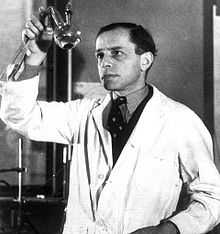Rudolph Schoenheimer
| Rudolph Schoenheimer | |
|---|---|
 | |
| Born |
May 10, 1898 Berlin |
| Died |
September 11, 1941 Suicide |
| Nationality | German/ U.S. |
| Fields | biochemistry |
| Institutions | Columbia University |
| Alma mater | Friedrich Wilhelm University |
| Known for | isotope tagging of biomolecules |
| Influenced | Peter D. Klein, Ph.D. |
Rudolph Schoenheimer (May 10, 1898 – September 11, 1941) was a German/ U.S. biochemist who developed the technique of isotope tagging of biomolecules, enabling detailed study of metabolism. This work revealed that all the constituents of an organism are in a constant state of chemical renewal.
Born in Berlin, after graduating in medicine from the Friedrich Wilhelm University there, he learned further organic chemistry at the University of Leipzig and then studied biochemistry at the University of Freiburg[1] where he rose to be Head of Physiological Chemistry.
He spent the 1930-31 academic year at the University of Chicago.
In 1933, following the rise of the Nazis to power he emigrated from Germany to the Columbia University to join the department of Biological Chemistry. Working with David Rittenberg, from the radiochemistry laboratory of Harold C. Urey and later together with Konrad Bloch, they used stable isotopes to tag foodstuffs and trace their metabolism within living things.[1]
He further established that cholesterol is a risk factor in atherosclerosis.[1] Link to photograph
He suffered from manic depression all of his life,[2] which lead to him in 1941 committing suicide using cyanide.[1] He had been honoured with the request to give the Dunham Lecture at Harvard before his death. It was read for him following his death.
References
- Kennedy, E P (2001), "Hitler's gift and the era of biosynthesis", J. Biol. Chem. (Nov 16, 2001) 276 (46): 42619–31, doi:10.1074/jbc.R100051200, PMID 11559714
- Young, V R; Ajami, A (1999), "The Rudolf Schoenheimer Centenary Lecture. Isotopes in nutrition research", The Proceedings of the Nutrition Society (Feb 1999) 58 (1): 15–32, PMID 10343336
- Olson, R E (1997), "The dynamic state of body constituents (Schoenheimer, 1939)", J. Nutr. (May 1997) 127 (5 Suppl): 1041S–1043S, PMID 9164302
- Guggenheim, K Y (1991), "Rudolf Schoenheimer and the concept of the dynamic state of body constituents.", J. Nutr. (Nov 1991) 121 (11): 1701–4, PMID 1941176
- Ratner, S; Rittenberg, D; Keston, A S; Schoenheimer, R (1987), "The Journal of Biological Chemistry, Volume 134, June 1940: Studies in protein metabolism. XIV. The chemical interaction of dietary glycine and body proteins in rats. By S. Ratner, D. Rittenberg, Albert S. Keston, and Rudolf Schoenheimer", Nutr. Rev. (Oct 1987) 45 (10): 310–2, PMID 3320825
- Shemin, D (1987), "On the impact on biochemical research of the discovery of stable isotopes: the outcome of the serendipic meeting of a refugee with the discoverer of heavy isotopes at Columbia University", Anal. Biochem. (Mar 1987) 161 (2): 365–9, doi:10.1016/0003-2697(87)90464-7, PMID 3555154
- Sinohara, H (1986), "[Rudolf Schoenheimer: a biographical essay]", Seikagaku (Dec 1986) 58 (12): 1449–70, PMID 3553368
- Goldstein, J L (1986), "On the origin and prevention of PAIDS (Paralyzed Academic Investigator's Disease Syndrome)", J. Clin. Invest. (Sep 1986) 78 (3): 848–54, doi:10.1172/JCI112652, PMC 423687, PMID 3528221
- Stetten, D (1982), "Rudi", Perspect. Biol. Med. 25 (3): 354–68, PMID 6763679
Bibliography
- [Anon.] (2001) "Schoenheimer, Rudolf", Encyclopaedia Britannica, Deluxe CDROM edition
- Medawar, Jean: Pyke, David (2012). Hitler's Gift: The True Story of the Scientists Expelled by the Nazi Regime (Paperback). New York: Arcade Publishing. ISBN 978-1-61145-709-4.
|